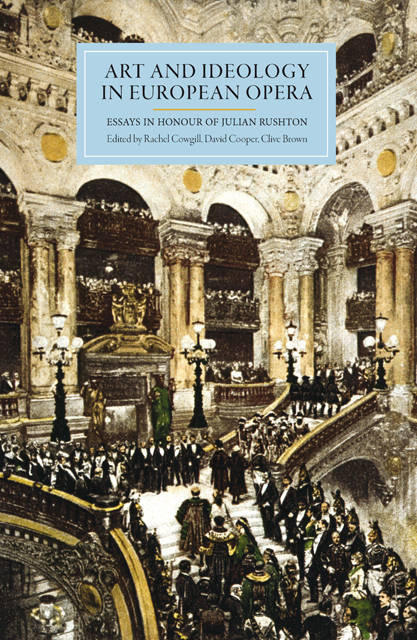Book contents
- Frontmatter
- Contents
- List of Figures
- List of Music Examples
- List of Tables
- Notes on Editors and Contributors
- Acknowledgements
- Introduction
- I Nationalism, Cosmopolitanism and National Opera
- II Opera, Class and the Politics of Enlightenment
- III Opera and Otherness
- Julian Rushton: A Family Memoir
- 7 The Works of Julian Rushton
- Index
- Tabula Gratulatoria
9 - New Light and the Man of Might: Revisiting Early Interpretations of Die Zauberflöte
Published online by Cambridge University Press: 28 February 2023
- Frontmatter
- Contents
- List of Figures
- List of Music Examples
- List of Tables
- Notes on Editors and Contributors
- Acknowledgements
- Introduction
- I Nationalism, Cosmopolitanism and National Opera
- II Opera, Class and the Politics of Enlightenment
- III Opera and Otherness
- Julian Rushton: A Family Memoir
- 7 The Works of Julian Rushton
- Index
- Tabula Gratulatoria
Summary
Among Mozart's operatic works Die Zauberflöte has proved to be the most enigmatic; much scholarly ink has been spilt in search of a key to its ‘secrets’ and a convincing interpretation of its ‘allegory’. That Die Zauberflöte should have become the focus of such hermeneutic obsession is due mainly to lack of evidence concerning Mozart's and Schikaneder's collaboration in the months leading up to the premiere, and a frustrated desire to find a coherent philosophical vision befitting a composer of Mozart's genius behind the bewildering twists, turns and esoteric symbolism of the text. Particularly vexing to critics has been the apparent reversal of plot and character motivations in the finale of Act 1, which gave rise to the theory of a ‘break’ [Bruchtheorie] or fundamental change of plan, first voiced around 1840: whilst some have understood this reversal as a deliberate strategy on the part of Mozart and Schikaneder to put clear water between their project and a successful revival by their competitor Karl Marinelli of the Perinet/Muller Singspiel Kaspar der Fagottist; oder, Die Zauberzither in the early summer of 1791; others have taken it as evidence of the involvement of additional authors, most prominently Karl Ludwig Gieseke, in producing the libretto for Mozart. More recently, however, it has been argued that the ‘break’ was an intentional plot device – a crucial moment of recognition facilitating the central characters’ progress towards enlightenment, and an intergenerational shift of power that transforms a world at war into a world at peace.
Readings have tended to locate Die Zauberflöte within three main contextual frameworks – freemasonry, fairy-tale opera and Enlightenment thought – which have been seen to overlap, particularly in view of freemasonry's historical role in nurturing debate around the philosophical ideas central to late eighteenth-century European culture. Freemasons themselves, or at least some German-speaking ones, appear to have understood the work in terms of masonic discourse as early as 1794. But the status of Die Zauberflöte as a ‘Masonic opera’ (that is, as an opera within which Mozart and Schikaneder deliberately encoded the tenets of freemasonry) has been called into question recently by David J. Buch.
- Type
- Chapter
- Information
- Art and Ideology in European OperaEssays in Honour of Julian Rushton, pp. 194 - 221Publisher: Boydell & BrewerPrint publication year: 2010

